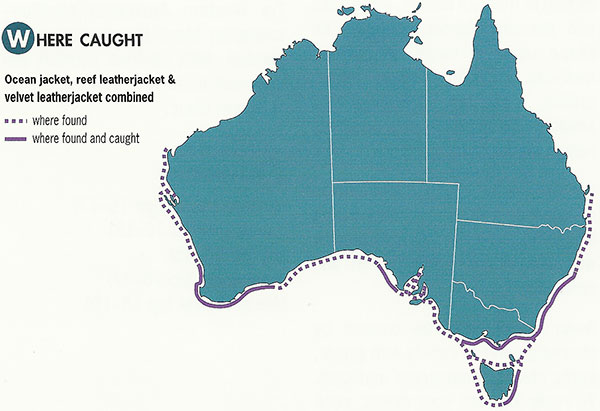Ocean jacket has a mild flavour.
Fillets are usually boneless, trunks usually have the backbone left in and can be cooked this way or made into cutlets
Scientific name: Nelusetta ayraud
Family: Monacanthidae
Other names: Chinaman leatherjacket, ocean leatherjacket, yellow jacket, chunks, leatherjonnie, sand leather jacket, filefish
Description: Ocean jacket have a long snout and head. They are characterised by the sharp spine on top of the heads and rudimentary pelvic fins. Adult females and juveniles are pale yellowish brown with orange-yellow fins. Juveniles have 1-4 longitudinal dark brown stripes along their body. Adult males are greenish grey, sometimes with 2‑3 dark blotches on their sides, with bright yellow fins.
Size (length and weight): Up to 1 metre in length and 3.5 kg. Commonly found at about 40 cm in length and 0.8-1.5 kg.
Life span: Up to 9 years.
Habitat: Ocean jacket are a demersal species that inhabits the continental shelf and slope. They are often found at depths down to 200 metres. Size tends to increase with water depth. Juveniles are often found in inshore waters in seagrass, estuaries and on rocky reefs, and move into deeper waters as they mature. Ocean jacket are highly mobile.
Prey: Salps, gastropods, crustaceans, squid and fish.
Predators: Larger carnivorous fish such as sharks and tunas.
Reproduction: Ocean jacket reach reproductive maturity after about 2.5 years of age. Spawning occurs over a period of about 3 months. Peak spawning activity appears to peak during autumn for populations off South Australia and late winter for populations off New South Wales. Spawning fish form large aggregations in water 85-200 metres deep. Females produce about 0.7‑2 million eggs per spawning season depending on body size. Unlike a number of closely related species, ocean jackets are broadcast spawners with no parental egg care.
Other: The name ‘leatherjacket’ comes from the thick, tough, leathery skin, which lacks normal scales and can be peeled off like a jacket. It is said that the dried skin was once used to polish wooden boats.
Ocean jackets are aggressive predators. They often form loose, small schools when feeding and are known to attack larger fish.
| Fishery found in | Gear used | Catch of this species is targeted or incidental |
|---|---|---|
| Southern and Eastern Scalefish and Shark Fishery – Commonwealth Trawl Sector | Bottom trawl | Incidental |
| Southern and Eastern Scalefish and Shark Fishery – Commonwealth Trawl Sector | Danish seine | Incidental |
| Southern and Eastern Scalefish and Shark Fishery – Great Australian Bight Sector | Bottom trawl | Incidental |
| Southern and Eastern Scalefish and Shark Fishery – Great Australian Bight Sector | Danish seine | Incidental |
Commercial fishermen are required to fill in records of their catches, during each fishing trip and when they land their catch in a port. This helps us keep records of how much is being caught.
AFMA monitor the amount of ocean jacket caught each year and , if needed, seek expert advice and recommendations from fisheries managers, industry members, scientist and researchers about management arrangements.
Ocean jackets can be found around southern Australia from Western Australia to New South Wales. Ocean jackets occur on the continental shelf and slope and often over bare sand and rocky substrates and are caught in depths of approximately 100-150 metres.
Ocean jacket are caught in two different fishing sectors of the Southern and Eastern Scalefish and Shark Fishery. They are not specifically targeted in either fishery, but are incidentally caught when fishing for other species.
The name ocean jacket can sometimes be applied to a variety of species. However, catch in these sectors are dominated by the species Nelusetta ayraud.

Fishers catch ocean jackets using trawl nets and danish seine nets.
Sometimes, bottom trawling can catch unwanted species of fish (not the type of fish the net was supposed to catch). This is known as bycatch and it is monitored by on-board fishery observers who assess the environmental impact of the trawling.
Although it is not physically possible to trawl on reef structures, significant long-term damage can occur if sensitive habitat areas like corals, sponges and seagrass beds are trawled. To ensure these sensitive habitat areas are protected from trawling, management arrangements such as area closures are extensively used.
The danish seine method of fishing has minimal impacts on the environment as it does not come into contact with the seafloor.
AFMA carries out ecological risk assessments (ERA) for all of its major fisheries. The impact of bottom trawl and danish seine on bycatch species and habitats has been assessed as part of the ERA. AFMA mitigates or reduces that impact through its ecological risk management (ERM) strategy. The ERM details a number of management arrangements and strategies which aim to reduce the impact of fishing on the environment. In the Commonwealth Trawl Sector and Great Australian Bight Sector, this includes minimum mesh sizes for otter trawls to reduce the catch of small and juvenile fish, mitigation devices to reduce interactions with threatened, endangered and protected species and spatial closures to protect vulnerable species and habitats.
Gear
Want to know more?
This is just an overview of ocean jacket, if you want to know more see the links below.
This fish is managed under the Southern and Eastern Scalefish and Shark Fishery.